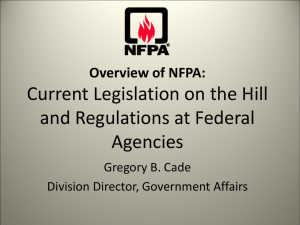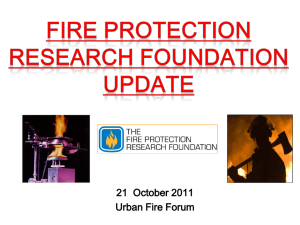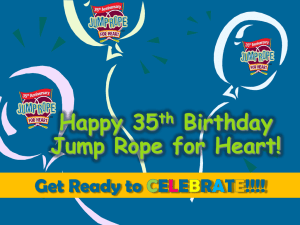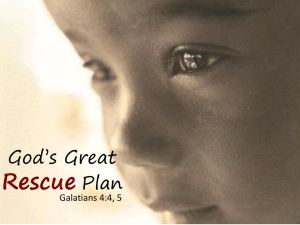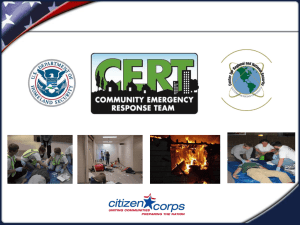My Confusion Surrounding NFPA Standards and Rope
advertisement
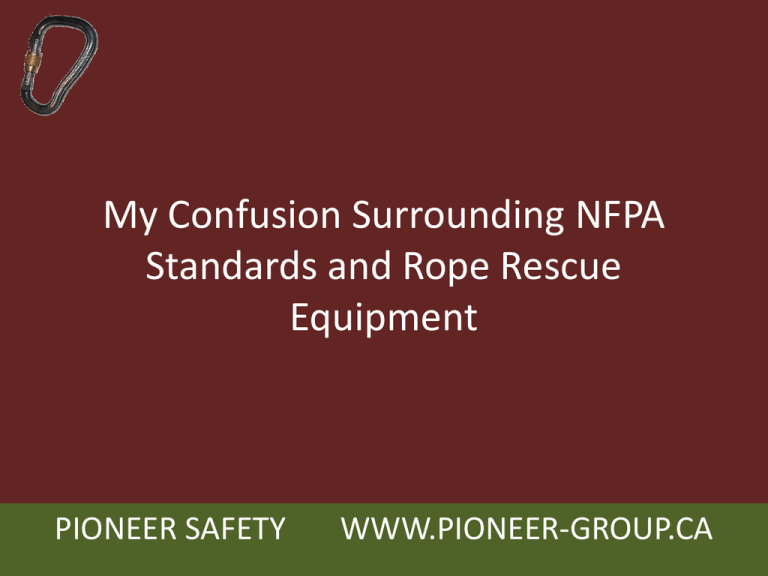
My Confusion Surrounding NFPA Standards and Rope Rescue Equipment PIONEER SAFETY WWW.PIONEER-GROUP.CA • Excerpts taken from Jim Kovach’s ITRS presentation with permission. • Presentation called ”Why the fire service should ingnore NFPA 1983” PIONEER SAFETY WWW.PIONEER-GROUP.CA How it started... • I started as a rescuer • Was involved in equipment purchasing • Wanted to ensure the correct legislation/standards were followed • Received conflicting information from others in the field • Looked at other rescue providers PIONEER SAFETY WWW.PIONEER-GROUP.CA Just so we are clear... • I support the use of NFPA standards • I follow them in my training courses • Other equipment I do use that is not NFPA rated meets or exceeds their requirements PIONEER SAFETY WWW.PIONEER-GROUP.CA First Conflicting Advice “You should only use NFPA rated equipment” (based on the 1983 standard) PIONEER SAFETY WWW.PIONEER-GROUP.CA First Problem Rope rescue gear that is not covered by NFPA... • • • • • Belay devices Prussik cord Webbing Stretchers and litters Casualty harnesses (rescue diaper) PIONEER SAFETY • Load releasing hitches • Bridles WWW.PIONEER-GROUP.CA So what does your organization use for belay??? • 540 is rated as “L” or “G” to NFPA 1983 under pulleys • The MPD is “G” rated under the designation of pulley and descent control device PIONEER SAFETY WWW.PIONEER-GROUP.CA Standards NFPA has, that most rescue teams don’t use • NFPA 1951 for helmets (The majority of rescue teams use the petzl Vertex or Erin Roc) • Portable anchors in 1983 for tripods (there is only 1 on the market for purchase anyway..) • Anchor straps in 1983 (most teams use webbing or the PMI Vari Rigger, neither are NFPA rated) PIONEER SAFETY WWW.PIONEER-GROUP.CA First Conclusion • You require gear that is not NFPA rated • Don’t just choose gear because of the standard but because of: – Safety factor – System compatibility PIONEER SAFETY WWW.PIONEER-GROUP.CA Second conflict • “NFPA states that you can not use L-rated equipment for a 2 person load, only G-rated” Do they???? PIONEER SAFETY WWW.PIONEER-GROUP.CA NFPA 1983 • Old versions for G rated equipment stated: – 600 lb MWL 2- person • New version states: – The definition of “general use” is: One designation of equipment item or manufactured systems designed for general-use loads, light-use loads, and escape based on design loads and performance requirements”. End of quote. The key phrase here is “based on design loads”. PIONEER SAFETY WWW.PIONEER-GROUP.CA • Why the change? • Why did they remove the 2-person 600 lb statement? • Who is 1983 for? • Is a 2 person rescue load really 280kg? PIONEER SAFETY WWW.PIONEER-GROUP.CA More confusion... • • • • • “G” rope = MBS 40kN “G” pulleys = MBS 36kN “G” Descent control device = MBS 22 “G” pick off strap = 27 kN “G” rated auxiliary equipment have 6 different MBS – 45kN, 40kN, 36Kn, 27kN, 22kN and 11 kN???? PIONEER SAFETY WWW.PIONEER-GROUP.CA As an instructor I was told.. • You can’t use 11mm rope for rescue on our site, it is only “L” rated! • 11mm New England KMIII rope MBS 35 kN • The G rated friction device I use to control the rescue load MBS = 22kN • Why can’t I use it? PIONEER SAFETY WWW.PIONEER-GROUP.CA Excerpt from Jim Kovach’s ITRS presentation in 2005 One of the questions submitted to the NFPA was: Can light-use life safety rope be used to support multiple persons (two or more)? These are the answers received from the NFPA. Mr. Frank Florence, the NFPA Staff Liaison to 1006 gave the following opinion. • Question: Can light-use life safety rope be used to support multiple persons (two or more)? • Answer: Rope use techniques are outside the scope of this document. Rope standards are covered in NFPA 1983, Standard on Fire Service Life Safety Rope and System Components. PIONEER SAFETY WWW.PIONEER-GROUP.CA The question submitted to Bruce Teele, the NFPA Staff Liaison to 1983 for the 2001 edition was different but relevant: • Question: How is the design load for life safety rope determined? • Answer: Users of rope need to consider the types of operations expected to be performed, the loads the rope is expected to bear, and set purchase specifications at or above the requirements of NFPA 1983 to assure the safety deemed necessary for such operations and loads will be met by their equipment. PIONEER SAFETY WWW.PIONEER-GROUP.CA Questions 1 and 2: Is it the intent of 1983 to establish a safety factor for rope or auxiliary equipment? If so, what is the safety factor? • Answer: On Questions 1 and 2, The scope statements in Section 1 of NFPA 1983 do not address “safety factors” but do address that the standard is based on minimum design, performance, testing, and certification requirements. Safety factors, as such, are not specified in NFPA 1983. PIONEER SAFETY WWW.PIONEER-GROUP.CA Mr. Donald C. Cooper, past secretary and current chairman of 1670, supplied the following opinion during a telephone conversation: • Question: Can light-use life safety rope be used to support multiple persons (two or more)? • Answer: NFPA 1670 does not describe how specific techniques are done, nor does it prohibit any technique. That would be up to the AHJ. PIONEER SAFETY WWW.PIONEER-GROUP.CA As Jim Kovach put it..... “And here is another question for the fire service. If we can use a “general use” rated descender with a MBS of 4,946 lbf or a “general use” rated rope grab with a MBS of 2,500 lbf, then why can’t we use an aluminum carabiner with a “light use” rating of 6,069 lbf along with them? That’s a rating of 1,123 pounds stronger than the “general use” descender and 3,569 pounds stronger than the “general use” rating of the rope grab.” PIONEER SAFETY WWW.PIONEER-GROUP.CA Conclusion #2 • Chose gear certified to an approved/recognized standard with a MBS that fits within your safety factor • Focus more on studying and understanding our system safety factors and less on a standard that was not written for us PIONEER SAFETY WWW.PIONEER-GROUP.CA Third Conflict • “The NFPA states that you must achieve a 15:1 safety factor” or • “The NFPA states that you must achieve a 10:1 safety factor” • Does the NFPA recommend a safety factor? PIONEER SAFETY WWW.PIONEER-GROUP.CA • Conversation from chat posts on firehall.com PIONEER SAFETY WWW.PIONEER-GROUP.CA From Jim Kovach’s report Questions concerning NFPA 1670 were answered in a telephone conversation with the chairman of that committee. • Question: Does 1670 require or recommend a 15:1 safety factor for rope rescue? • Answer: No • Question: Does 1670 require or recommend a 10:1 safety factor for rope rescue? • Answer: No • Question: Does 1670 have a required or recommended safety factor for rope rescue? • Answer: NFPA does not require or specify any safety factor. PIONEER SAFETY WWW.PIONEER-GROUP.CA • Question: Does 1500 require a 15:1 safety factor for rope rescue? • Answer: NFPA 1500 requires life safety rope meet NFPA 1983. • Question: Does 1500 require a certain safety factor for rope rescue? If so, what is it? • Answer: NFPA 1500 requires life safety rope meet NFPA 1983. PIONEER SAFETY WWW.PIONEER-GROUP.CA • The 15:1 safety factor myth came from NFPA 1983 (old versions) where they stated for the manufacturer’s that life safety rope is to be designed with a SWL of 600lbf and a MBS of 9000lbf • I have come across Dept’s who have 16mm rope trying to achieve this! PIONEER SAFETY WWW.PIONEER-GROUP.CA • It is up to your organization what your static system safety factor will be • Choose it because it meets your risk assessments • 10:1 is a standard industry practice PIONEER SAFETY WWW.PIONEER-GROUP.CA Conclusion • Before we quote standards , we must know for sure • Just because someone says it doesn't make it true • Choose equipment that fits within your SSSF PIONEER SAFETY WWW.PIONEER-GROUP.CA
